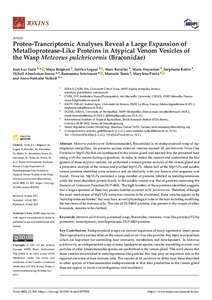| dc.contributor.author | Gatti, J.L. |
| dc.contributor.author | Belghazi, M. |
| dc.contributor.author | Legeai, F. |
| dc.contributor.author | Ravallec, M. |
| dc.contributor.author | Frayssinet, M. |
| dc.contributor.author | Robin, S. |
| dc.contributor.author | Aboubakar-Souna, D. |
| dc.contributor.author | Srinivasan, R. |
| dc.contributor.author | Tamo, M. |
| dc.contributor.author | Poirie, M. |
| dc.contributor.author | Volkoff, A.N. |
| dc.date.accessioned | 2021-08-04T10:45:31Z |
| dc.date.available | 2021-08-04T10:45:31Z |
| dc.date.issued | 2021 |
| dc.identifier.citation | Gatti, J.L., Belghazi, M., Legeai, F., Ravallec, M., Frayssinet, M., Robin, S., ... & Volkoff, A.N. (2021). Proteo-trancriptomic analyses reveal a large expansion of metalloprotease-like proteins in atypical venom vesicles of the wasp Meteorus pulchricornis (Braconidae). Toxins, 13(7), 502: 1-37. |
| dc.identifier.issn | 2072-6651 |
| dc.identifier.uri | https://hdl.handle.net/20.500.12478/7202 |
| dc.description.abstract | Meteorus pulchricornis (Ichneumonoidea, Braconidae) is an endoparasitoid wasp of lepidopteran caterpillars. Its parasitic success relies on vesicles (named M. pulchricornis Virus-Like Particles or MpVLPs) that are synthesized in the venom gland and injected into the parasitoid host along with the venom during oviposition. In order to define the content and understand the biogenesis of these atypical vesicles, we performed a transcriptome analysis of the venom gland and a proteomic analysis of the venom and purified MpVLPs. About half of the MpVLPs and soluble venom proteins identified were unknown and no similarity with any known viral sequence was found. However, MpVLPs contained a large number of proteins labelled as metalloproteinases while the most abundant protein family in the soluble venom was that of proteins containing the Domain of Unknown Function DUF-4803. The high number of these proteins identified suggests that a large expansion of these two protein families occurred in M. pulchricornis. Therefore, although the exact mechanism of MpVLPs formation remains to be elucidated, these vesicles appear to be “metalloproteinase bombs” that may have several physiological roles in the host including modifying the functions of its immune cells. The role of DUF4803 proteins, also present in the venom of other braconids, remains to be clarified. |
| dc.description.sponsorship | French National Agency of Research |
| dc.description.sponsorship | French National Institute for Research in Agriculture, Food and Environment |
| dc.description.sponsorship | French Government |
| dc.format.extent | 1-36 |
| dc.language.iso | en |
| dc.subject | Meteorus |
| dc.subject | Insects |
| dc.subject | Pests of Plants |
| dc.subject | Pest Insects |
| dc.subject | Braconidae |
| dc.subject | Proteomic |
| dc.subject | Transcriptome |
| dc.subject | Metalloproteins |
| dc.subject | Venoms |
| dc.title | Proteo-trancriptomic analyses reveal a large expansion of metalloprotease-like proteins in atypical venom vesicles of the wasp Meteorus pulchricornis (Braconidae) |
| dc.type | Journal Article |
| cg.contributor.affiliation | Université Côte d’Azur |
| cg.contributor.affiliation | Aix-Marseille University |
| cg.contributor.affiliation | Université de Rennes |
| cg.contributor.affiliation | University of Montpellier |
| cg.contributor.affiliation | International Institute of Tropical Agriculture |
| cg.contributor.affiliation | World Vegetable Center |
| cg.coverage.hub | Headquarters and Western Africa Hub |
| cg.researchtheme | Plant Production and Health |
| cg.identifier.bibtexciteid | GATTI:2021 |
| cg.isijournal | ISI Journal |
| cg.authorship.types | CGIAR and advanced research institute |
| cg.iitasubject | Agronomy |
| cg.iitasubject | Pests of Plants |
| cg.iitasubject | Plant Breeding |
| cg.iitasubject | Plant Health |
| cg.iitasubject | Plant Production |
| cg.journal | Toxins |
| cg.notes | Open Access Journal; Published online: 19 Jul 2021 |
| cg.accessibilitystatus | Open Access |
| cg.reviewstatus | Peer Review |
| cg.usagerightslicense | Creative Commons Attribution 4.0 (CC BY 0.0) |
| cg.targetaudience | Scientists |
| cg.identifier.doi | https://dx.doi.org/10.3390/toxins13070502 |
| cg.iitaauthor.identifier | Manuele Tamò: 0000-0002-5863-7421 |
| cg.futureupdate.required | No |
| cg.identifier.issue | 7: 502 |
| cg.identifier.volume | 13 |
| cg.contributor.acknowledgements | The authors thank Andrea Becchimanzi and Franco Pennacchio from the University of Napoli ‘Federico II’, Italy, for sharing the assembled transcriptome of Bracon nigricans. |

